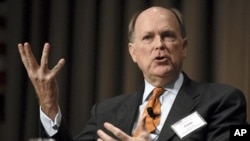Top U.S. officials have repeatedly said the consequences of a possible default are so severe there is no alternative to raising the debt ceiling. But with less than two weeks to go until the August 2 deadline, key U.S. agencies and private financial firms are also planning for a worst-case scenario.
The chief of the Philadelphia branch of the U.S. central bank tells Reuters that the Federal Reserve is working with the Treasury Department on what to do if and when the government runs out of money.
Philadelphia Fed chief Charles Plosser says policy makers are in "contingency planning mode," trying to determine which debts would be paid. He says the Fed is trying to determine what to do with U.S. Treasuries, like bonds. Many private banks use bonds as collateral in order to get cash loans from the central bank.
The New York Times said Thursday several prominent financial firms are working on their own "doomsday plans" (plans to deal with a worst-case scenario).
Some firms are moving to reduce their holdings of Treasury bonds while some investment funds are stockpiling cash.
Other companies are coming up with plans for how to do business if a default causes interest rates to spike, increasing theit day-to-day operating costs.
US Government, Companies Prepare for Unthinkable Default












